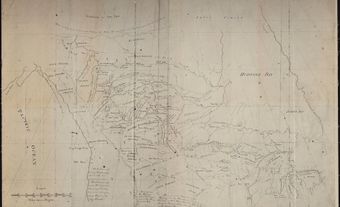Henri de Tonty, explorer, voyageur (b 1649 or 1650; d at Ft Louis-de-la-Louisiane Sept 1704). He was the son of Lorenzo de Tonty, inventor of the "tontine" system of life annuity. He served in the French army and navy and had his right hand blown away by a grenade. In 1678 he travelled to New France as lieutenant to La Salle and supervised construction of Fort Conti and the bark Griffon (1679) on the Niagara River. He led a party to the Illinois River, helping to build Fort Miami and then Fort Crèvecoeur (1680), but while he was absent from Crèvecoeur, his men mutinied, destroying the buildings. Tonty also survived an Iroquois attack, a canoe wreck near Green Bay and near starvation. In 1681 he led an advance party to Chicago portage and was rejoined by his commander La Salle; the expedition reached the Gulf of Mexico 7 April 1682. In 1686 Tonty and LaSalle claimed the territory for the French and helped Denonville in his campaign against the Iroquois by organizing the Illinois in a rearguard action, and in 1690 he was granted the fur-trading concession after La Salle's murder. In 1698 Tonty returned to the Mississippi, under Pierre Le Moyne d'Iberville's command, working to expand trade, but he died of yellow fever. The Indigenous people called him bras de fer as much for his tenacity and courage as for his hook-shaped artificial arm.
-
- MLA 8TH EDITION
- Marsh, James H.. "Henri de Tonty". The Canadian Encyclopedia, 16 December 2013, Historica Canada. www.thecanadianencyclopedia.ca/en/article/henri-de-tonty. Accessed 18 April 2024.
- Copy
-
- APA 6TH EDITION
- Marsh, J. (2013). Henri de Tonty. In The Canadian Encyclopedia. Retrieved from https://www.thecanadianencyclopedia.ca/en/article/henri-de-tonty
- Copy
-
- CHICAGO 17TH EDITION
- Marsh, James H.. "Henri de Tonty." The Canadian Encyclopedia. Historica Canada. Article published January 07, 2008; Last Edited December 16, 2013.
- Copy
-
- TURABIAN 8TH EDITION
- The Canadian Encyclopedia, s.v. "Henri de Tonty," by James H. Marsh, Accessed April 18, 2024, https://www.thecanadianencyclopedia.ca/en/article/henri-de-tonty
- Copy
Thank you for your submission
Our team will be reviewing your submission
and get back to you with any further questions.
Thanks for contributing to The Canadian Encyclopedia.
CloseArticle
Henri de Tonty
Article by James H. Marsh
Published Online January 7, 2008
Last Edited December 16, 2013
Henri de Tonty, explorer, voyageur (b 1649 or 1650; d at Ft Louis-de-la-Louisiane Sept 1704). He was the son of Lorenzo de Tonty, inventor of the "tontine" system of life annuity.

 Share on Facebook
Share on Facebook Share on X
Share on X Share by Email
Share by Email Share on Google Classroom
Share on Google Classroom

